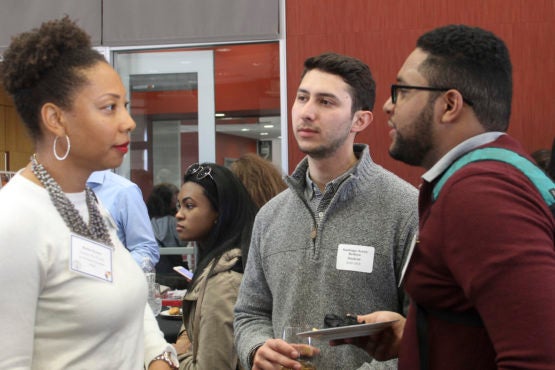Stanford welcomes prospective grad students from diverse backgrounds
Stanford will welcome prospective graduate students to campus Friday for Graduate Recruitment and Diversity Day, an annual event designed to help recruit outstanding scholars who would contribute to the diversity of their academic fields and to the diversity of the university’s graduate community.
Stanford will welcome more than 60 prospective graduate students to campus Friday for Graduate Recruitment and Diversity Day (GRAD Diversity Day), which introduces admitted graduate students and promising candidates to the resources, programs and supportive community that help students from diverse backgrounds thrive on the Farm.

Anika Green, assistant vice provost for graduate education, and director of the Diversifying Academia, Recruiting Excellence Doctoral Fellowship Program, chats with prospective graduate students at the 2018 GRAD Diversity Day. (Image credit: L.A. Cicero)
During GRAD Diversity Day, the students will meet members of Stanford’s faculty and staff, including senior diversity officers, as well as current graduate students.
Academic departments will hold special events for the visitors, who are considering master’s and doctoral programs in five schools: the School of Earth, Energy & Environmental Sciences, the Graduate School of Business, the Graduate School of Education, the School of Engineering and the School of Humanities and Sciences.
The prospective graduate students are arriving from across the nation and from six foreign countries: Canada, Colombia, Germany, Mexico, South Africa and the United Kingdom. They earned undergraduate degrees at more than 45 institutions, including Arizona State University, Stanford, Spelman College, Tecnológico de Monterrey and Yale University.
Each year, Stanford invites prospective students to attend GRAD Diversity Day, which was designed to help recruit outstanding graduate students who would contribute to the diversity of their academic fields and to the university’s graduate community.
Catie Cuan, a doctoral student in mechanical engineering, said participating in last year’s event helped her make the decision to come to Stanford.
“I went on tours of a research lab and a classroom that provided important insight into daily activities on campus,” said Cuan, who is interested in design and robotics. “I especially enjoyed meeting students from other departments as my interests are interdisciplinary. The graduate housing tour was informative since I would be moving to Stanford with my partner I wanted to ensure we would both be comfortable in campus housing.”
Diverse students bring valuable insights
At Stanford, diversity is broadly defined and includes, but is not limited to, categories of culture, socioeconomic background, race, ethnicity, gender, gender identity, sexual orientation, disabilities, religion and life experience.
Each of Stanford’s seven schools has diversity officers who can answer questions about graduate programs in their school.
Patricia J. Gumport, vice provost for graduate education and postdoctoral affairs, said Stanford genuinely values the diverse life experiences and identities of its graduate students.
“Advancing diversity in graduate education is essential to fulfilling our mission in education, research and service,” she said. “Graduate students with very different life experiences, identities and perspectives enrich learning and advance knowledge in every field, as they identify new questions and bring invaluable insights,” Gumport said. “We are working strategically to foster an inclusive environment that values the contributions of all individuals.”
Stanford offers more than 200 graduate degree programs throughout its seven schools.
Gumport, who is also a professor of education, said the Office of the Vice Provost for Graduate Education (VPGE) works within the entire university to broaden the participation and promote the academic success of all graduate students, including scholars who are underrepresented within research universities.
“A distinctive feature of graduate education at Stanford is our highly collaborative community,” she said. “With over 9,400 students pursuing master’s, doctoral and professional degrees in all seven Schools, we are nonetheless one university that explicitly values diversity and seeks to be an ever-more inclusive community.”
Gumport said Stanford has developed a variety of programs designed to promote diversity within its graduate student community, including two competitive fellowships offered by the VPGE Office: Enhancing Diversity in Graduate Education Fellowship Program for incoming doctoral students, and Diversifying Academia, Recruiting Excellence Doctoral Fellowship Program for advanced doctoral students who want to prepare for academic careers.
GRAD Diversity Day workshop, tours, reception
GRAD Diversity Day will open with a welcome breakfast in Old Union and close with a reception in the Mackenzie Room of the Jen-Hsun Huang Engineering Center.
Throughout the day, the prospective graduate students will meet with faculty, staff and current graduate students. They will also visit academic departments.
“Each individual department or school has its own culture,” said Eric C. Abrams, chief inclusion officer at the Graduate School of Education. “I hope our visitors learn a bit about these unique cultures and how they might find a home here.”
Abrams and Greg Graves, graduate recruiter and retention coordinator at the Native American Cultural Center, are the co-chairs of this year’s GRAD Diversity Day.
During a midday workshop, the prospective graduate students will learn about the importance of establishing and maintaining a good relationship with their PhD advisors – a relationship that is critical to the success of doctoral students.
This year, the Center for Comparative Studies in Race and Ethnicity is hosting an open house for the visitors.
The program also includes guided tours of Stanford Centers for Equity, Community and Leadership, including El Centro Chicano y Latino, Queer Student Resources and the Black Community Services Center, as well as guided tours of offices dedicated to diversity and inclusion, and to first-generation and low-income students.
